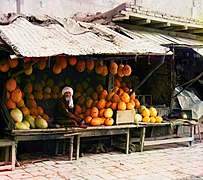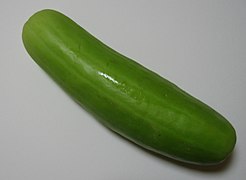Cucumis melo
| Cucumis melo | |
|---|---|

| |
| Scientific classification | |
| Kingdom: | Plantae |
| Clade: | Tracheophytes |
| Clade: | Angiosperms |
| Clade: | Eudicots |
| Clade: | Rosids |
| Order: | Cucurbitales |
| Family: | Cucurbitaceae |
| Genus: | Cucumis |
| Species: | C. melo
|
| Binomial name | |
| Cucumis melo | |
| Synonyms[1] | |
|
List
| |
Cucumis melo, also known as melon,[2][3] is a species of Cucumis that has been developed into many cultivated varieties. The fruit is a pepo. The flesh is either sweet or bland, with or without an aroma, and the rind can be smooth (such as honeydew), ribbed (such as European cantaloupe), wrinkled (such as Cassaba melon), or netted (such as American cantaloupe). The species is sometimes referred to as muskmelon,[4] but there is no consensus about the usage of this term, as it can also be used as a specific name for the musky netted-rind American cantaloupe, or as a generic name for any sweet-flesh variety such the inodorous smooth-rind honeydew melon.[5][6]
The origin of melons is not known. Research has revealed that seeds and rootstocks were among the goods traded along the caravan routes of the Ancient World. Some botanists consider melons native to the Levant and Egypt, while others place their origin in Iran,[7] India or Central Asia.[8] Still others support an African origin, and in modern times wild melons can still be found in some African countries.[9]
Background
[edit]The melon is an annual, trailing herb.[8] It grows well in subtropical or warm, temperate climates.[9] It can be found as a weed around sites of recently built airports in American Samoa.[10]
Melons prefer warm, well-fertilized soil with good drainage that is rich in nutrients,[8] but are vulnerable to downy mildew and anthracnose. Disease risk is reduced by crop rotation with non-cucurbit crops, avoiding crops susceptible to similar diseases as melons. Cross pollination has resulted in some varieties developing resistance to powdery mildew.[11] Insects attracted to melons include the cucumber beetle, melon aphid, melonworm moth and the pickleworm.[11]
Genetics
[edit]| NCBI genome ID | 10697 |
|---|---|
| Ploidy | diploid |
| Genome size | 374.77 Mb |
| Number of chromosomes | 12 |
| Year of completion | 2012 |
Melons are monoecious or andromonoecious plants.[12] They do not cross with watermelon, cucumber, pumpkin, or squash, but varieties within the species intercross frequently.[13] The genome of Cucumis melo was first sequenced in 2012.[14] Some authors treat C. melo as having two subspecies, C. melo agrestis and C. melo melo. Variants within these subspecies fall into groups whose genetics largely agree with their phenotypic traits, such as disease resistance, rind texture, flesh color, and fruit shape. Variants or landraces (some of which were originally classified as species; see the synonyms list to the right) include C. melo var. acidulus (Mangalore melon), adana, agrestis (wild melon), ameri (summer melon), cantalupensis (cantaloupe), reticulatus (muskmelon), chandalak, chate, chito, conomon (Oriental pickling melon), dudaim (pocket melon), flexuosus (snake melon), inodorus (winter melon), momordica (snap melon), tibish, chinensis and makuwa (Oriental melon).
Not all varieties are sweet melons. The snake melon, also called the Armenian cucumber and Serpent cucumber, is a non-sweet melon found throughout Asia from Turkey to Japan.[15][9] It is similar to a cucumber in taste and appearance.[16] Outside Asia, snake melons are grown in the United States, Italy, Sudan and parts of North Africa, including Egypt.[9] The snake melon is more popular in Arab countries.[16]
Other varieties grown in Africa are bitter, cultivated for their edible seeds.[9]
For commercially grown varieties certain features like protective hard netting and firm flesh are preferred for purposes of shipping and other requirements of commercial markets.[11]
Nutrition
[edit]For a reference amount of 100 g (3.5 oz), a raw cantaloupe melon provides 34 calories and is a rich source (defined as at least 20% of Daily Value, DV) of both vitamin A and vitamin C; other micronutrients are at a negligible level.[17] A raw melon is 90% water and 9% carbohydrates, with less than 1% each of protein and fat.[17]
Uses
[edit]In addition to their consumption when fresh, melons are sometimes dried. Other varieties are cooked, or grown for their seeds, which are processed to produce melon oil. Still other varieties are grown only for their pleasant fragrance.[18] The Japanese liqueur Midori is flavored with melon.
It was once a frequently cultivated plant in Tonga (katiu) as a snack and its flowers used for leis, but has since been extirpated.[19]
History
[edit]There is debate among scholars whether the abattiach in The Book of Numbers 11:5 refers to a melon or a watermelon.[20] Both types of melon were known in Ancient Egypt and other settled areas. Some botanists consider melons native to the Levant and Egypt, while others n Persia,[21] India or Central Asia, thus the origin is uncertain. Researchers have shown that seeds and rootstocks were among the goods traded along the caravan routes of the Ancient World.[8] Several scientists support an African origin, and in modern times wild melons can still be found in several African countries in East Africa like Ethiopia, Somalia and Tanzania.[9]
Melon was domesticated in West Asia and over time many cultivars developed with variety in shape and sweetness. Iran, India, Uzbekistan, Afghanistan and China become centers for melon production.[9] Melons were consumed in Ancient Greece and Rome.[22]
Gallery
[edit]-
Japanese "crown melon" intended as a high-priced gift: The pictured crown melon is 6300 yen, or about US$59
-
'Squared melon' grown in Atsumi District, Aichi Japan, known as kakumero
-
The Armenian cucumber, despite the name, is actually a type of melon.
-
Melon vendor in Samarkand (between 1905 and 1915)
-
Muskmelon seeds
See also
[edit]- Armenian cucumber - a cucumber-like variety of melon
- Bailan melon
- Barattiere – a landrace variety of melon found in Southern Italy
- Canary melon
- Carosello – a landrace variety of melon found in Southern Italy
- Crane melon
- Gaya melon
- Hami melon
- Korean melon
- Melon ball
- Melon Day
- Montreal melon
- Sugar melon
- Karit fruit
References
[edit]- ^ The Plant List: A Working List of All Plant Species, retrieved 23 January 2016
- ^ "Cucumis melo". Germplasm Resources Information Network. Agricultural Research Service, United States Department of Agriculture.
- ^ "Definition of Melon by Oxford Dictionary". Lexico Dictionaries | English. Archived from the original on June 28, 2021. Retrieved 2021-02-13.
- ^ Parsons, James (1745). The Microscopical Theatre of Seeds. Vol. 1. London: F. Needham. p. 338.
- ^ "Melon". Encyclopedia Britannica. Retrieved 2021-02-13.
- ^ "Definition of muskmelon". Dictionary by Merriam-Webster. Retrieved 2021-02-13.
- ^ Raghami, Mahmoud; López-Sesé, Ana Isabel; Hasandokht, Mohamad Reza; Zamani, Zabihollah; Moghadam, Mahmoud Reza Fattahi; Kashi, Abdolkarim (2014-01-01). "Genetic diversity among melon accessions from Iran and their relationships with melon germplasm of diverse origins using microsatellite markers". Plant Systematics and Evolution. 300 (1): 139–151. Bibcode:2014PSyEv.300..139R. doi:10.1007/s00606-013-0866-y. ISSN 1615-6110.
Melons or muskmelon are native to Iran and adjacent countries toward the west and east. In fact, 'Musk' is a Persian word for a kind of perfume and 'melon' is derived from Greek words (Robinson and Decker-Walters 1997). The origin of diversity for melon was traditionally believed to be in Africa (Robinson and Decker-Walters 1997), although recent molecular systematic studies, suggested that it may be originated from Asia and then reached to Africa (Renner et al. 2007). Central Asia, Iran, Afghanistan, India, Transcaucasia, Turkmenistan, Tajikistan, and Uzbekistan, as well as Afghanistan and China (Robinson and Decker-Walters 1997) are considered primary diversity centre for melon (Tzitzikas et al. 2009).
- ^ a b c d Swenson, Allan A. (1995). Plants of the Bible: And How to Grow Them. Citadel Press. p. 77. ISBN 9780806516158. Retrieved 26 August 2019.
- ^ a b c d e f g Grubben, G. J. H. (2004). Vegetables. PROTA Foundation. p. 243. ISBN 9789057821479. Retrieved 26 August 2019.
- ^ Whistler, Art (2011). Rare Plants of Samoa. Conservation International. p. 93. ISBN 978-982-9130-02-0.
- ^ a b c Beattie, James Herbert (1951). Muskmelons. Agricultural Research Service. Retrieved 26 August 2019.
- ^ "Cucumis melo in Flora of North America". eFloras.org. Retrieved 2024-06-15.
- ^ Martin Anderson, Texas AgriLife Extension Service. "Muskmelons Originated in Persia - Archives - Aggie Horticulture". tamu.edu.
- ^ Jordi Garcia-Mas (2012). "The genome of melon (Cucumis melo L.)". Proceedings of the National Academy of Sciences. 109 (29): 11872–11877. Bibcode:2012PNAS..10911872G. doi:10.1073/pnas.1205415109. PMC 3406823. PMID 22753475.
- ^ Ashworth, Suzanne (2012-10-31). Seed to Seed: Seed Saving and Growing Techniques for the Vegetable Gardener. Chelsea Green Publishing. p. 97. ISBN 9780988474901. Retrieved 26 August 2019.
- ^ a b Goldman, Amy (January 2002). Melons: For the Passionate Grower. Artisan Books. p. 112. ISBN 9781579652135. Retrieved 26 August 2019.
- ^ a b "Nutrition Facts for 100 g of melon, cantaloupe, raw". FoodData Central, US Department of Agriculture. 16 December 2019. Retrieved 3 January 2025.
- ^ National Research Council (2008-01-25). "Melon". Lost Crops of Africa: Volume III: Fruits. Vol. 3. National Academies Press. doi:10.17226/11879. ISBN 978-0-309-10596-5. Retrieved 2008-07-17.
- ^ Whistler, Art (2011). The Rare Plants of Tonga (PDF). Tonga Trust Ltd. pp. 81–2.
- ^ "We remember the fish, which we did eat in Egypt freely; the cucumbers, and the melons, and the leeks, and the onions, and the garlick" Numbers 11:5
- ^ Raghami, Mahmoud; López-Sesé, Ana Isabel; Hasandokht, Mohamad Reza; Zamani, Zabihollah; Moghadam, Mahmoud Reza Fattahi; Kashi, Abdolkarim (2014-01-01). "Genetic diversity among melon accessions from Iran and their relationships with melon germplasm of diverse origins using microsatellite markers". Plant Systematics and Evolution. 300 (1): 139–151. Bibcode:2014PSyEv.300..139R. doi:10.1007/s00606-013-0866-y. ISSN 1615-6110.
Melons or muskmelon are native to Iran and adjacent countries toward the west and east. In fact, 'Musk' is a Persian word for a kind of perfume and 'melon' is derived from Greek words (Robinson and Decker-Walters 1997). The origin of diversity for melon was traditionally believed to be in Africa (Robinson and Decker-Walters 1997), although recent molecular systematic studies, suggested that it may be originated from Asia and then reached to Africa (Renner et al. 2007). Central Asia, Iran, Afghanistan, India, Transcaucasia, Turkmenistan, Tajikistan, and Uzbekistan, as well as Afghanistan and China (Robinson and Decker-Walters 1997) are considered primary diversity centre for melon (Tzitzikas et al. 2009).
- ^ Ensminger, Marion Eugene (1993-11-09). Foods & Nutrition Encyclopedia, Two Volume Set. CRC Publisher. ISBN 9780849389801. Retrieved 26 August 2019.
External links
[edit]- Cucumis melo L. – Purdue University, Center for New Crops & Plant Products.
- Sorting Cucumis names – Multilingual multiscript plant name database
- Cook's Thesaurus: Melons – Varietal names and pictures
- "Cucumis melo". Plants for a Future.








